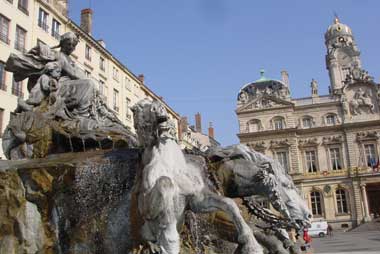Off Duty: Lyon
Extend a business trip to France’s second city, where gourmet splendour is guaranteed - and, says Harriet O’Brien, there is much more besides

Your support helps us to tell the story
From reproductive rights to climate change to Big Tech, The Independent is on the ground when the story is developing. Whether it's investigating the financials of Elon Musk's pro-Trump PAC or producing our latest documentary, 'The A Word', which shines a light on the American women fighting for reproductive rights, we know how important it is to parse out the facts from the messaging.
At such a critical moment in US history, we need reporters on the ground. Your donation allows us to keep sending journalists to speak to both sides of the story.
The Independent is trusted by Americans across the entire political spectrum. And unlike many other quality news outlets, we choose not to lock Americans out of our reporting and analysis with paywalls. We believe quality journalism should be available to everyone, paid for by those who can afford it.
Your support makes all the difference.Why?
Look beyond the urban sprawl of industry and banking and you'll find that Lyon is a place of astonishing verve, art and invention.
Its reputation for gourmet distinction is today its most obvious attraction, but there is much else as well. This is a pioneering city par excellence: it was in Lyon that the cinema was essentially created, and here that town illumination developed as a real art form. Meanwhile public art is very much a contemporary expression of the people: painted from the late 1980s, about 180 huge murals decorate street corners and celebrate the city's publishing past, its silk weaving heritage, its role during World War II as the effective capital of the Resistance, and much more. Vieux Lyon, the ancient core of the city, is an atmospheric and intriguing tangle of medieval cobbled streets nestling beneath a steep hill. The area is riddled with traboules - winding, semi-secret passageways that run through buildings and link inner courtyards to the old streets. Beyond the historic heart lies the Presqu'ile (the peninsula) straddled by the rivers Saone and Rhone. The 17th-, 18th- and 19th- century neighbourhoods here offer a diverse mix of grandeur and working-class grit. More of the 19th-century lies beyond the Rhone, Haussman avenues that lead to modern, skyrise Lyon.
What?
At the Musee des Tissus at 34 Rue de la Charite just south of the city's huge central square, Bellecour, you'll get an absorbing insight into the world of decorative fabrics with stunning exhibits of carpets, wall hangings and stupendous silks (open daily except Mon 10am-5.30pm; €5; www.musee-des-tissus.com). The museum reflects Lyon's re-eminent past as a silk weaving centre, and a visit here could be followed by a wander up to La Croix-Rousse hill where in the 19th century the silk weavers lived and plied their art in tall, tightly packed houses.
Over on the city's grandest square, Place des Terreaux, the Musee des Beaux Arts is set in a gracious, 17th-century convent. Its elegant courtyard decorated with Rodin sculptures is a foretaste of its highly regarded collection - especially its Impressionists - and the museum is often referred to as the 'Petit Louvre' (open daily except Tues 10am-6pm, €6; www.mba-lyon.fr).
Meanwhile one of Lyon's most dramatic sights is its Roman complex on Fourviere hill above the old town. In 1933 two enormous Roman theatres were discovered here and subsequently excavated. These great arenas were sculpted, side by side, out of the slope with a row of Roman lavatories placed between them. Significant performances must have taken place here: one theatre would have seated 10,000 people, the other about 3,000 (open daily 9am until nightfall; free admission).
Where?
Vieux Lyon is lined with traditional, rustic-style restaurants complete with check tablecloths and hams strung from the ceiling. Known as bouchons (from the word for cork), they serve local fare such as sausages, chops and tripe. For typical atmosphere make for Le Petit Glouton at 56 rue St Jean.
In the 19th-century Lyon started to become a serious gourmet destination when a number of cooks serving big households started their own restaurants. These women, known as 'Les Meres de Lyon', set the standards of quality and sophistication that continue today. The most famous of Lyon's epicurean artists is Paul Bocuse, whose restaurant empire in the city includes the brasseries Le Nord, Le Sud, L'Est and L'Ouest ( www.bocuse.fr). Bocuse was the driving force behind the development of the city's excellent food market. Set in the Part Dieu business district, Les Halles looks blandly unpromising from its grey exterior but inside it is a gourmet haven not only containing upscale stalls selling cheeses, hams, fish and more, but also offering some excellent cafes where local gourmands gather.
Wow
See where cinema began, at the street suitably entitled Rue de Premier Film. This is where the Lumiere brothers lived and invented the means of showing moving images and their home in the Monplaisir district subsequently developed into a studio and factory. Today it is a museum and film centre (open daily except Mon 11am-6.30pm; €6 ( www.institut-lumiere.org).
Join our commenting forum
Join thought-provoking conversations, follow other Independent readers and see their replies
Comments